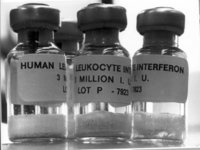PURPOSE: In controlled studies, subcutaneous injection of interferon gamma (IFN-[gamma]) has been shown to be ineffective in the treatment of idiopathic pulmonary fibrosis (IPF). One explanation for the lack of efficacy may be inadequate drug levels in the lung interstitium using subcutaneous dosing strategies. We have developed an aerosol of IFN-[gamma] designed to target the airways directly. We present the dose to the lung, local cytokine response, and clinical course in a 38 year old woman with biopsy proven usual interstitial pneumonia, treated with aerosolized IFN-[gamma].
METHODS: The patient received 400 [micro]g of aerosol IFN-[gamma] (two 200 [micro]g doses) three times per week. Pulmonary function test (PFT), exercise testing, and the University of California, San Diego shortness of breath questionnaire (SOBQ) were performed and completed prior to starting IFN-[gamma] therapy and at the end of three months. Subsequent PFTs were performed at the discretion of the patient's private pulmonologist. Bronchoalveolar lavage was assayed for transforming growth factor-beta (TGF-[beta]) prior to the start and at the end of three months. The pattern of deposition and dose to the lung parenchyma were measured by gamma camera.
RESULTS: Clinical responses included decreased dyspnea with improvement in her SOBQ measurement, stabilization of pulmonary function tests (improvement in DLCO/VA from 51% to 68% and stabilization of FEV1 and TLC) and improvement in objective parameters during exercise testing (increased maximal oxygen consumption). The dose to the lung parenchyma, as measured by gamma camera, was 54.4 [micro]g per treatment with a peripheral deposition pattern. With this regimen, bronchoalveolar lavage TGF-[beta], a key molecular mediator of matrix deposition, levels decreased.
CONCLUSION: This is the first report of aerosol treatment with IFN-[gamma] and measurement of lung deposition in a patient with IPF. This study illustrates the potential use of aerosolized IFN-[gamma] for the treatment of IPF by means of targeted therapy directly at the site of disease.
CLINICAL IMPLICATIONS: This is a novel approach in the treatment of IPF.
DISCLOSURE: Hooman Mobassery, Product/procedure/technique that is considered research and is NOT yet approved for any purpose. Interferone gamma is FDA approved but the delivery of this drug by aerosol is considered experimental.
Hooman Mobassery MD * Rany Condos MD Gerald C. Smaldone MD SUNY at Stony Brook University Hospital, Stony Brook, NY
COPYRIGHT 2005 American College of Chest Physicians
COPYRIGHT 2005 Gale Group



